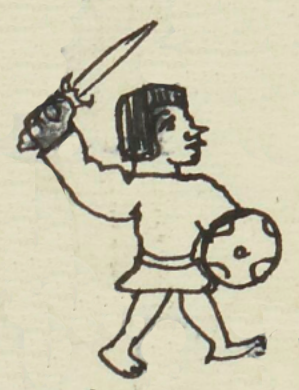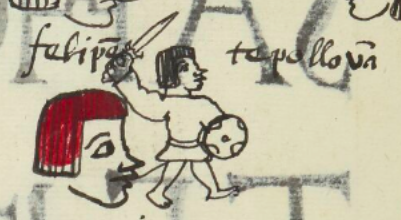Tepoloa (MH549v)
This black-line drawing of the simplex glyph for the personal name Tepoloa ("To Defeat in War," attested here as a man's name) could be a shortened version of the word tepoloani (see the dictionary link). It is a man walking and looking toward the viewer's right, but his body is in a frontal view. His posture suggests that he is ready to enter battle. In his right hand he hold a sword raised up. In his left hand he holds a round, Indigenous war shield, decorated with four half-circles connected to the perimeter of the circle, and a small round circle at the center. The man wears no shoes. His tunic appears to be of a European style, with a belt at the waist and longish with a short, flared bottom part (possibly trunk hose?).
Stephanie Wood
Swords were introduced by Europeans. Nahuas had the maccuahuitl, a club studded with obsidian blades, flint knives, and bows and arrows. The shield shown here is similar to the one shown in the glyph for Chimalpopoca in the Matrícula de Huexotzinco. See also the two men facing off in a sword battle in the glyph for the personal name, Cochilla.
Stephanie Wood
tepollovan
Tepolohuan
Stephanie Wood
1560
Jeff Haskett-Wood
victors, ganadores, conquistadores, espadas, escudos, nombres de hombres

tepoloa, to defeat people in war, https://nahuatl.wired-humanities.org/content/tepoloa
tepoloani, victor in war, https://nahuatl.wired-humanities.org/content/tepoloani
poloa, to destroy, https://nahuatl.wired-humanities.org/content/poloa
te-, nonspecific human object prefix, people, https://nahuatl.wired-humanities.org/content/te
tepehuani, victor in war, https://nahuatl.wired-humanities.org/content/tepehuani
El Que Derrota a la Gente en Guerra
Stephanie Wood
Matrícula de Huexotzinco, folio 549v, https://www.loc.gov/resource/gdcwdl.wdl_15282/?sp=178&st=image
This manuscript is hosted by the Library of Congress and the World Digital Library; used here with the Creative Commons, “Attribution-NonCommercial-ShareAlike 3.0 License” (CC-BY-NC-SAq 3.0).





